公開日 2021年11月12日
Yayoi Period
The Beginning of Agriculture
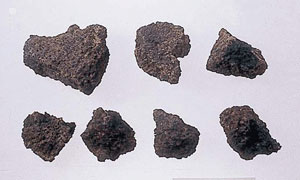
Rice farming was introduced across the sea from the Korean Peninsula or the Chinese continent about 2,500 years ago.First, this new culture arrived in the northern part of Kyushu, then gradually spread all over Japan, reaching the Tohoku region several hundred years later.People obtained the skills to produce their own food by farming, which was totally different from hunting and gathering life that depended on the blessings of nature.
Metals such as iron and bronze were brought to Japan simultaneously.Metal tools were much more efficient than the stone ones in tilling the land, cutting down the trees or using as weapons, and thus improved people’s lives drastically.It was in this period that the concept of the social class came to Japan. The length of time which lasted 750 years is called the Yayoi period.It started about 2,500 years ago, when the new culture was introduced, and ended when making kofun, burial mounds, became popular.Regarding when the Yayoi period began, there is a new theory which claims that it can date back to 1000BC (about 3,000 years ago) according to their recent study.So far, no school textbooks have been rewritten, but probably in the future, there will be a different description of when it started.
The photo above shows burnt and carbonized rice in the earthenware excavated from the Kumonji site, Tsubonouchi.
Yayoi Villages and Battles
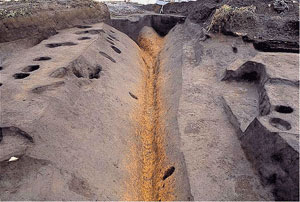
The Hosoya site, Ishida, has remains of a village enclosed with a deep ditch to protect from the enemy’s attack.
No remains of the early Yayoi period were so far discovered in Isehara.The oldest artifact of the Yayoi period is the earthenware from the first half of the mid-Yayoi period, unearthed at the Akasaka site in Takamori.The oldest artifact of the Yayoi period is the earthenware from the first half of the mid-Yayoi period, unearthed at the Akasaka site in Takamori.
A deep ditch could defend the village from the enemies’ attacks. Therefore, the villages enclosed with ditches mean there were battles among the villages as the full-scale wet cultivation of rice developed.Some villages became wealthier than the others; some households became richer than the others though they belong to the same community.In this way, people came to be distinguished in different classes.Especially in western Japan, human bones stuck with an arrowhead and wounded bones were unearthed, which proves that they had fierce battles against the other groups.
Old Chinese historical documents mention the ancient Japanese state “Wa”, describing it as a nation disturbed by frequent armed clashes.Although in the Kanto region no evidence was found to prove that people had raged battles, it is obvious that this period was not always quiet and peaceful.
A Wide Network in the Yayoi Period
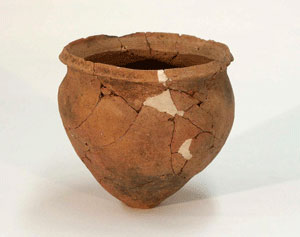
Yayoi earthenware, 26.2cm high, was excavated from the remains of a village enclosed with ditches in the Hosoya site, Ishida.
It shows a strong influence of earthenware made in Hamamatsu, Shizuoka Prefecture.
In the late Yayoi period, people lived in the two major areas in Isehara: Ishida, situated in the east; Sannomiya and Zenba in the west.
Ishida had some villages enclosed with deep ditches.Earthen vessels made with skills peculiar to Hamamatsu and its vicinity, Shizuoka Prefecture, were excavated from the Mine and Hosoya sites.On the other hand, approximately 100 dwellings were found in Osumidai’s Nakabando and Kaminozaike sites.Sannomiya’s Maehata dwelling site produced earthenware with special features unique to Fukuroi and Kakegawa, Shizuoka Prefecture.The excavated earthenware and the style of the pit dwellings show that people came in a group from the western part of Shizuoka Prefecture to settle along the Sagami River.From the Kumonji site in Tsubonouchi, the remains of a workshop to produce beads made of local green tuff for necklaces were excavated.Presumably, a group of skilled craftsmen moved here from the Hokuriku region, which was the center of the production of beads at that time.From the late-Yayoi-period remains in Isehara, polished-stone tools, common to see so far, were hardly excavated.This happened, most probably, due to the spread of the iron tools which had taken place of stone tools.Ironware was not yet produced in the Kanto region then.It means iron tools were brought here from western Japan. After all, the late Yayoi period was the time of unrest when people frequently moved, actively exchanged with the people in the far distance, and caused friction among the groups.The distribution system developed in this period made it possible to build big burial mounds and eventually paved the way to establishing an ancient nation.
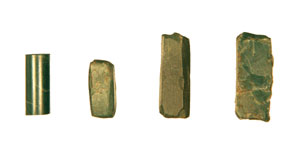
- The bead on the left is 2.1cm long; the others are workpieces.
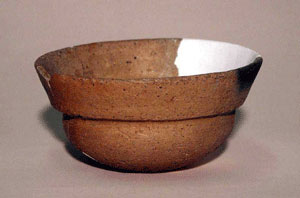
- This earthenware, 14.5cm in diameter at the top, 7.2cm in height, was found in the remains of a workshop where beads were produced.
The skilled craftsmen are assumed to have moved from the Hokuriku region.
- Geogaraphical Features of Isehara
- Paleolithic Period
- Jomon Period
- Yayoi Period
- Kofun (Tumulus)Period
- Nara Period
- Heian Period
- Kamakura Period
- Muromachi Period
- Civil War Period
- Edo Period
- Meiji, Taisho, and Showa Periods
Previous⇒Jomon Period


